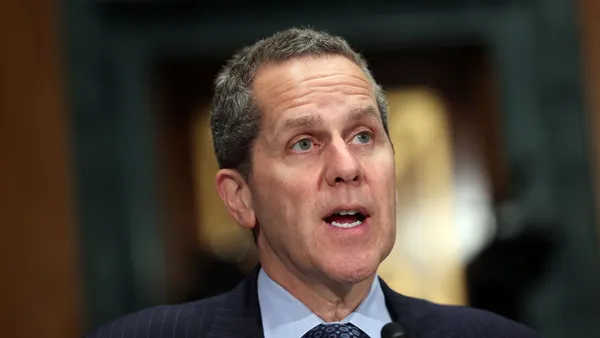Dive Brief:
- The Senate confirmed Michael Barr by a 66-28 vote Wednesday to serve as the Federal Reserve’s vice chair for supervision for a four-year term. Lawmakers earlier in the day confirmed Barr to a 10-year stint on the central bank’s board of governors.
- Barr is the fifth official appointed to the Fed board under the Biden administration. His confirmation gives the central bank a full seven-member board for the first time since August 2013, American Banker reported.
- The Fed’s vice chair for supervision role has been vacant since October, when Randal Quarles’ term expired. Since then, the central bank’s Committee on Supervision and Regulation has met “as necessary” and “on an unchaired basis,” according to a Fed spokesperson.
Dive Insight:
Barr is set to face a number of supervisory issues in the banking sphere once he is sworn in. He is expected to embody a tougher stance toward mergers and acquisitions, in line with an executive order President Joe Biden issued last year calling for “more robust scrutiny” of the tie-ups.
Any tightening of regulation would come in concert with the Office of the Comptroller of the Currency (OCC), which is reviewing the framework of the merger process. Regulators are considering how to incorporate public feedback on proposed tie-ups. And Acting Comptroller Michael Hsu has said the OCC is leaning toward holding more public meetings over combinations involving large banks. (A meeting on the Bank of Montreal’s proposed acquisition of Bank of the West is set for Thursday.) The Federal Deposit Insurance Corp. (FDIC), meanwhile, issued a request for information in March regarding mergers involving insured depository institutions.
“I think it will be a pretty big fight as Barr looks to protect the Fed’s prerogative over mergers, but also has to work with other regulators who have proved they are not afraid to break norms in order to try to push regulation further left,” Brandon Barford, a partner at research firm Beacon Policy Advisors, told The Wall Street Journal.
Barr undoubtedly will also play a crucial role in implementing an evolving Community Reinvestment Act (CRA) — another shift requiring coordination among regulators. The Fed, OCC and FDIC proposed updates to the 1977 anti-redlining law in May — and the agencies are seeking public comment on the changes through early August. Barr would be the central bank’s point person on further policy tweaks there.
And Barr likely will revisit policy on the supplementary leverage ratio (SLR), an element governing banks’ capital requirements. The Fed temporarily eased its SLR rules at the start of the COVID-19 pandemic, such that Treasurys and deposits wouldn’t count among banks’ assets. But the central bank let that exception expire last year, promising to give the policy another look. It hasn’t yet. Fed Chair Jerome Powell and others have said the ratio may need to be adjusted over the higher volume of deposits within the Fed system.
Democrats may be looking for Barr to roll back some of what they saw as regulatory easing during Quarles’ tenure in the Fed’s supervisory post. Issues that may get a second look include a Volcker Rule revamp that curbed speculative bank investments and perhaps a move to toughen annual stress tests — especially regarding climate risk.
But support for Barr came not just from Democrats. Sen. Pat Toomey, R-PA, the Senate Banking Committee’s ranking member, issued a statement Wednesday explaining his backing.
“While I disagree with Professor Barr on a number of policy issues, he has pledged to fight the record high inflation that’s hurting American families,” Toomey said. “He has also publicly acknowledged that the Fed does not have the authority to, nor should it, allocate credit or use its regulatory powers to accelerate the transition to a lower carbon economy.”
Gaining Toomey’s support — particularly in regard to climate — has been challenging but crucial for Democratic nominees seeking a seat at the regulation table.
Toomey masterminded a boycott of Biden’s previous candidate for the Fed’s supervisory role, Sarah Bloom Raskin, that appeared rooted in Raskin’s personal view that oil, gas and coal companies should have been ineligible for government-backed emergency-lending relief at the start of the COVID pandemic. However, Toomey also criticized Raskin over allegations she used her influence to persuade the Federal Reserve Bank of Kansas City to grant a fintech, Reserve Trust, a Fed master account. Raskin served on the fintech’s board at the time.
Barr was an early front-runner on Biden’s shortlist to lead the OCC. But left-wing activist groups, concerned about Barr’s own ties to the fintech sphere, opposed him. Biden ultimately chose Saule Omarova to helm the agency. She withdrew her nomination after lawmakers blasted her past writings about bank oversight — and about communism.
During Barr’s term, the Fed could start to formulate a regulatory blueprint for overseeing fintechs.
Barr is the last financial regulatory official that bank lobbyists expect the Biden administration to nominate before the November midterm elections, according to The Wall Street Journal. The OCC and FDIC are still being run by acting leaders. A White House official told the Journal that the administration would put forth nominations to fill those posts permanently but didn’t give a timeline.
At least one analyst — Isaac Boltansky, BTIG’s director of policy research — said he felt most policy shifts Barr would initiate in his new role would be incremental.
“He will be a thoughtful and effective leader, but we should be expecting his tenure to produce a series of targeted tweaks rather than a wholesale revision of the regulatory regime,” Boltansky told The Wall Street Journal.














